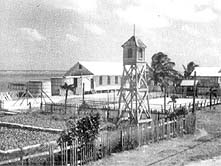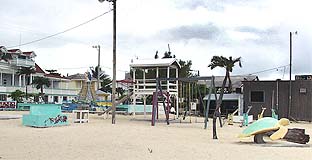|
|
The sound of a siren will usually signal the commencement of the curfew, which is called by the military in times of civil unrest or political unrest or any serious situation confronting a city or nation. In Belize in 1961, the siren was wailed for some five minutes after Hurricane Hattie and the British military took over the streets to protect from stealing of what remained in the stores and private homes. Then again in the 1970's when there was a lot of civil unrest due to the process of negotiations with Guatemala, the people took to the streets to destroy government buildings, to vandalize and to steal as well, and once again the curfew was imposed. Today our curfew in San Pedro is mainly called into force to keep thieves off the streets for the safety of homes and businesses and for the safety of our people.
Did you know that San Pedro Village had a voluntary curfew back in the 1950's and even into the 1960's? Any person who was going to school back then and who remembers the old bell tower at Central Park will be able to associate the bell with the curfews. There was no emergency, nor any threat, nor any eminent danger of drugs or civil unrest. In fact, there was never a meeting to discuss this curfew. It was automatic as far as custom was concerned. As long as there were classes, there was this curfew. At exactly 8 p.m., the police officer in charge of San Pedro rang the bell at Central Park. This told all school children they were to clear the streets and remain at home. They could be on the streets only for a short while after eight p.m., but in the company of their parents, and you can bet your sweet lip that the officer knew the children and their parents. After ringing the bell, the police officer would make his first round from one end of the village to the other, which was from the primary school area to Milo's Store area. This demarcated the ends of the village and there were only the beach and two streets. The back street or Angel Coral Street was all covered with mangrove in those days. That is why some of us still refer to the middle street as "back street". If the police officer caught you on the street, he could whip you or he could take you to your home and give your parents a good scolding. Due to this, children were extremely afraid of police officers. He was a man to be respected by all, young and old.
My personal anecdote I shall never forget. I was caught after 8 p.m. by Police Officer, Mr. Hope. However I knew that it was alright if a child was accompanied by his parents, and I thought very quickly. I saw don Chicho Valdez, the barber who lived near my house, and I quickly held on to his hands when the officer was near us. "Good night, Mr. Valdez," said the officer. "Good night, Sir," replied Mr. Chicho with a smile, knowing that I was asking for his protection. Since then, Mr. Chicho was one of my best senior friends and I always admired and respected him for saving me. (God bless him and keep him in Haven for saving me) Yes, indeed many children were whipped, many hated the police officer, and many officers were a bit harsh in exercising their duty or their powers, but never was this practice ever questioned. It was an established custom that was passed on from year to year, from officer to officer. Parents in San Pedro accepted the curfew as a means of getting their children home early. The next trick was telling them stories about the Sisimito, or La Llorona, or the Xtabai, or Tatabalan. Alright, here are the topics for the next issues of Twenty Five Years Ago-Characters in San Pedro Folklore or as the children knew them, " Los cuentos de espantos". Stay tuned.
|
|
|



